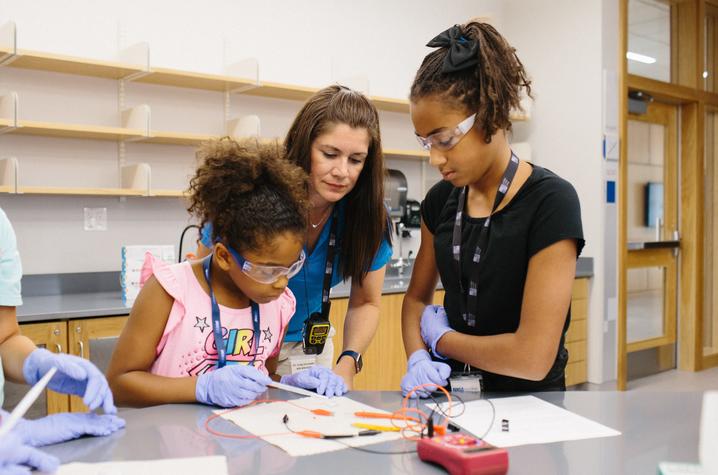College of Education Associate Dean Seeks to Break Through Barriers With First Handbook of STEM Education Research

University of Kentucky College of Education Professor and Associate Dean Margaret Mohr-Schroeder has dedicated her career, in part, to breaking down silos.
For more than a decade, Mohr-Schroeder has worked to remove barriers in order to facilitate authentic, hands-on educational opportunities for students in science, technology, engineering and mathematics, collectively known as STEM.
She brings this integrated, community-engaged and equity-focused perspective to "The Handbook of Research on STEM Education," a groundbreaking book she co-edited with three other well-respected STEM researchers.
“From the beginning of my work, I and the other editors of the book have long argued for an integrated approach to STEM,” Mohr-Schroeder said.
Rather than focusing on each STEM subject in isolation, the book analyzes research and policy within the realm of science, technology, engineering and mathematics education as a whole.
“In integrated STEM, you concentrate on curriculum, research, professional development opportunities, and activities, for example, that integrate two or more areas of STEM,” Mohr-Schroeder said. “That's not to say that each one in isolation is not important, but integrated STEM approaches are most like what students will see within a STEM career or even in a non-STEM career. We're often trained to take classes or study subjects in ‘silos.’ This makes it more difficult to contextualize where and how this might apply later in life — the infamous question, ‘When am I ever going to use this?’”
In STEM settings such as innovative summer camps or family STEM nights, students can immediately practice what they learn, by building robots that perform specific functions, for example, or creating a virtual reality short film, or extracting DNA from a strawberry and analyzing it. Learning experiences such as these have helped build bridges between higher education and K-12 schools by bringing public school students and teachers to college campuses, and college faculty, undergraduates and graduate students to public schools. At the same time, she has worked to build collaborations across the university, reaching across disciplines to work with professors with expertise in STEM subjects.
“STEM is not a replacement for deep content knowledge in a particular area. It's not about surface knowledge in each of the areas, but rather gaining deeper knowledge in one or more areas so that you can then collaborate with others to solve complex problems,” Mohr-Schroeder said.
STEM integration not only involves a more inclusive view of STEM subjects, but also access to high-quality STEM learning experiences for each and every student, especially underrepresented populations such as females and Black, Indigenous and people of color.
“Through those STEM learning experiences, we work to disrupt systems of oppression and privilege,” Mohr-Schroeder said. “The goal is to increase students' access to and knowledge of STEM literacy, helping them grow and become societal change agents.”
UK Associate Professor Cindy Jong also leads a critical chapter in the Handbook, “Race-related Factors in STEM: A Review of Research on Educational Experiences and Outcomes for Racial and Ethnic Minorities.”
Jong and co-authors use critical race theory as an analytical lens for their review. “Critical race theory is a timely framework to understand history and address the current climate, as it centralizes marginalized voices and emphasizes intersectionality among its multiple principles that unpack how racism operates in education and society,” Jong said. Intersectionality refers to the interconnectedness of race, class, gender and other individual characteristics, and overlapping systems of discrimination that compound experiences.
The chapter highlights factors that promote success among racial and ethnic minorities and encourage an asset perspective, which is a focus on strengths and solutions. When examining why there are so few minorities in STEM, it is common for researchers to ask questions that place blame rather than seeking solutions by exploring how environments cultivate meaningful experiences for students, Jong noted.
“We only scratched the surface of this topic due to word limitations, but I think this chapter provides a launching point and illuminates the research and policies needed to combat racist practices that have discouraged Black, Indigenous, and People of Color from participating in STEM for far too long,” Jong said.
The book includes a total of 37 chapters that dive deeply into the implementation of STEM since it was established as a field 20 years ago. The editors hope that it will help to support and guide future research into effective integrated STEM practice.
More from this series Research Support
Credits
Beth Goins (College of Education)


